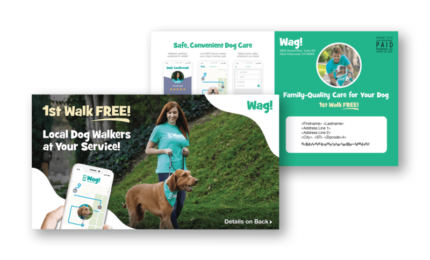Why is Direct Mail a Good Return on Investment?
By Paul Bobnak | January 28, 2025

We have some great news for marketers who count on the mailbox to help them communicate with customers and drum up business – news for those who ask “Are direct mailers effective?”
Mail enjoys some of the best response rates of any communications channel. According to the 2024 Lob State of Direct Mail Marketing, 84% of marketers say that direct mail provides the highest ROI of any channel they use.
That sounds pretty impressive, especially to marketers considering how to spend their budgets. Because we’re living in the Digital Age, it’s sometimes tempting to think of direct mail as passe, with nothing new to offer to today’s audiences.
But here’s the thing.
Technology – the factor that supposedly doomed mail and all things print – actually helps make direct mailers effective more now than ever before.
To understand how, consider direct mail’s advantages over the competition.
1. Mail has all the feels
Digital channels can use some of the same response-building tricks that direct mail has, like eye-catching images, or intriguing subject lines instead of teasers.
But can they make you feel?
Direct mail is tangible – it’s ink on paper – and so it immediately compels attention compared to a digital message.
Think about some of the ways a printed direct mail piece can stand out to a customer:
- Weight
- Shape
- Texture
- Colors
- Finishes
- Special papers and treatments
Papers, inks, and finishes can provide an interesting tactile experience for an entire envelope, folded self-mailer, or postcard, or to spotlight certain copy, images, or graphics. Thanks to advances in digital printing presses, the quality, speed to market, and affordability of many of these options is better than ever.
2. Direct mail is on the brain
So why does a physical experience provided by a marketer make a connection – tactile, emotional, or both – with the mail recipient?
Multiple neuroscience studies have shown that direct mail is easier to understand and more memorable than other communication channels – especially digital. According to market research firm True Impact, mail’s motivation response – the feeling of wanting that drives behavior – is 20% higher than digital media.
Of all direct mail formats cited in the True Impact study, envelopes and dimensional mailers (such as padded envelopes) scored the highest effectiveness rates. Formats with a high degree of sensory engagement performed best because of how they activated different parts of the brain.
3. Mailboxes are less cluttered
Every day, we’re exposed to hundreds of digital messages on multiple devices. Streaming, searching, emailing, texting, and surfing the web … it all adds up to a lot of visual clutter and noise.
One ad doesn’t look much different from the next, especially because they’re all displayed on the same single-sized screen, whether you’re looking at your phone, tablet, or PC. Consumers ignore almost all of them as they flow endlessly past their eyes.
Mail is different.
Personal letters and postcards that used to dominate First Class mail have moved to digital channels, for better or worse.
And marketers now know that spray-and-pray mass mailings are no longer the best strategy to reach audiences, especially because the alternatives have better ROI.
What this means is that, in a less-crowded mailbox, a carefully targeted direct mail piece can grab a customer’s attention as soon as they receive it and hold it in their hands.
4. Direct mail gets more personal
Now, just because a mailing feels or looks interesting doesn’t mean that it will be opened or acted upon. Unless it immediately touches a desire in the recipient that can be fulfilled by the offer it carries, it’s destined for the recycling bin.
Remember how I said that technology is making direct mail better than ever before? When it comes to how mail uses personal data, time has definitely not stood still.
Personalization and digital printing allow companies to present consumers with more options based on their data history and demographic profile. As a result, there are more opportunities for companies to create customized touchpoints for customers, whether as charts, images, maps, headlines, or offers.
A mail piece produced with variable data printing (VDP) raises the customer’s perception of the brand if done well. Depending on the relationship and industry, it can help companies cross-sell and up-sell products and services and retarget customers based on recent purchasing interest or behavior both online and offline. It also gives marketers a better chance to improve their marketing through improved modeling and more effective testing of offers and creative elements.
5. “Official” mail gets attention
Mail often has a regulatory or compliance purpose and it’s legally required to be sent in printed form. Think about tax issues, parking tickets, or even some important bills and checks. They can be easily missed, ignored, or not trusted as reliable when sent by email. And would you really trust a phone call about these matters, maybe asking for a credit card number or form of ID?
6. Mail has generational appeal
Mail works well across different generations of consumers. Defying conventional wisdom – that recent generations only care for digital channels – studies show that millennials love direct mail. Along with Generation Z audiences, millennials value tactile, offline, and more personal experiences that mail provides.
7. QR codes make response easier
When scanned by a customer, QR codes bridge the gap between the physical world of mail with the digital world of internet response. For consumers, they attract attention, bridge the gap from mail to digital, and make it super easy for consumers to take action on a product, service, or offer. For marketers, they provide important first-party customer interaction data as well as the ability to change landing pages, offers, and more during the course of a campaign.
Direct Mail Marketing Tips
Planning is the key to ensure that your direct mailers are effective in achieving a high ROI as well as a good response rate. To get started with that whole process, you should follow four vital tips:
- Determine your goals
- Clarify your audience
- Take your time
- Make an irresistible offer
These steps will help you identify the right resources (money, time, people) to meet your goals.
Statistics prove direct mailers are effective
Some people always look for the numbers, so here are a few statistics that show direct mail marketing is effective:
- 67% of marketers say direct mail provides the best ROI of any channel they use, according to a recent Lob survey of marketers
- 62% of consumers reported having taken action after reading a direct mail piece
- According to marketers in one survey, simply adding mail improves omnichannel response from 51% to 83% – a 63% increase
Wrapping it up
Remember, you still need a good strategy that weighs the merits of all of your channels and tools. Depending on your goals, budget, and schedule, direct mail alone might not be the best answer. In fact, direct mail can effectively drive traffic to websites on its own or when coordinated with an email campaign as part of an omnichannel approach. No single channel is best for any company.
But at the same time, we’re all aware that inboxes are inundated and digital ad channels are oversaturated. It’s time again to embrace direct mail, the old-school marketing tool that can deliver personalized messages and build engagement like digital but also offer a singular tactile presence that the digital experience can’t match.
The direct mail pros at mailing.com have decades of expertise working on campaigns for large companies as well as medium and small ones. We can help you put together a complete and cost-effective direct mail campaign to accomplish your goals quickly.
Please reach out to us! We’d love to show you how you can put modern direct mail to work in your next campaign.
Editor’s Note: This post was originally published in November 2019 and has been updated for accuracy and comprehensiveness as of January 2025.


